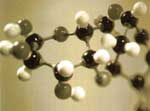|
||||||||||||||||||||||||||||||||||||||||||||||||||||||||||||||
|
Technology Introduction: ZirChrom's technology introduction is now available as a short, on-demand webinar. Visit ChromU to find your ZirChrom solution today!
POROUS ZIRCONIA Zirconia, or zirconium dioxide (ZrO2), is a metal oxide that can exist in a number of crystallographic and amorphous forms. The porous zirconia that is used for ZirChrom® columns is produced through the controlled polymerization induced aggregation of 1000 Å colloidal zirconia to produce monodisperse 3 micron porous zirconia spheres. These zirconia spheres are then sintered at temperatures reaching 900°C to produce a monoclinic crystallographic form of zirconia. ADVANTAGES OF POROUS ZIRCONIA The primary advantage of zirconia over either silica or polymeric stationary phases is its extreme chemical and thermal stability. Unlike silica, zirconia is completely stable over the entire pH range and at column temperatures as high as 200°C. Unlike polymeric phases, zirconia does not shrink or swell as a function of mobile phase organic content or ionic strength. It has very high mechanical strength and high efficiencies. This extreme stability results in a column that may be cleaned under harsh conditions (acidic or basic), and also results in a longer column lifetime. Long column life and stability translates to a reduced cost per analysis and a wider range of possible chromatographic conditions. Zirconia columns can and should be run at your oven’s highest temperature. The column will remain stable, providing faster analysis, less need for organic modifier and decreased system down time due to pump maintenance. Also refer to Specific Advantages of ZirChrom-PBD Columns. MODES OF SEPARATION OFFERED BY ZirChrom® COLUMNS Reversed-Phase Chromatography (RPC) is the most commonly used mode of HPLC employed, accounting for about 80% of all HPLC separations. All of ZirChrom's RPC supports are based on ultra-stable, highly efficient zirconia particles. ZirChrom offers five types of reversed-phase columns, giving chromatographers a wide range of selectivity options: DiamondBond®-C18 - a C18 modified carbon phase with very different selectivity from ODS ZirChrom®-EZ - an easy-to-use LC column; great for acidic and basic compounds ZirChrom®-MS - a general purpose LC/MS column, great for basic, acidic or mixed pharmaceutical samples ZirChrom®-CARB - ideal for closely related compounds; greatest difference in selectivity compared to ODS ZirChrom®-PBD - great for basic and neutral compounds; similar selectivity to ODS for non-electrolytes ZirChrom®-PS - ideal for highly aqueous mobile phases with alternative selectivity to ODS ZirChrom®-PBD (polybutadiene) and ZirChrom®-PS (polystyrene) are made by coating the zirconia with a thin layer of polymer. These phases have selectivity that is most similar to conventional bonded phases. ZirChrom®-EZ is made like ZirChrom®-PBD with an additional "end-capping" step that deactivates the zirconia surface in order to facilitate buffer selection and LC/MS use. ZirChrom®-CARB is made by coating zirconia with a very thin layer of elemental carbon. This carbon reversed-phase is very different from traditional RPC phases. When different reversed-phase selectivities are required, ZirChrom®-CARB offers a high efficiency alternative. Finally, DiamondBond®-C18 uses a proprietary covalent bonding technology to graft C18 groups to carbon's surface, giving it outstanding stability for LC/MS applications. DiamondBond®-C18 has selectivity that is intermediate between ODS silica and unbonded carbon supports. Ion-Exchange Chromatography (IEC) uses a stationary phase that contains ionic groups on the surface to separate analytes of a complimentary charge. Retention is based on the electrostatic interactions between analytes and the surface charge groups and is controlled by various mobile phase parameters, such as ionic strength, organic content and pH. ZirChrom offers two cation-exchange packings, ZirChrom®-WCX and ZirChrom®-PEZ, and three anion-exchange packing chemistries, ZirChrom®-WAX, ZirChrom®-SAX and ZirChrom®-SHAX. These columns are especially useful in the separation of small ionic compounds or larger biological molecules such as oligonucleotides, peptides and proteins including IgG. Normal Phase Chromatography (NPC) uses a polar stationary phase in conjunction with a nonpolar mobile phase (e.g. hexane/acetone). This mode is useful for separating isomers and for separating closely related compounds that differ in their polar functionality such as steroids. ZirChrom offers an unmodified zirconia packing, ZirChrom®-PHASE. Specialty Products are also available from ZirChrom. These products include Rhinophase®-AB, a pseudo-affinity phase for antibodies, and ProTain®, an in-line protein removal system.
|
|||||||||||||||||||||||||||||||||||||||||||||||||||||||||||||
|
||||||||||||||||||||||||||||||||||||||||||||||||||||||||||||||











